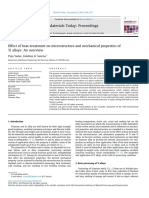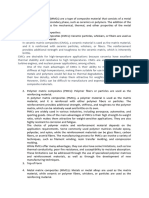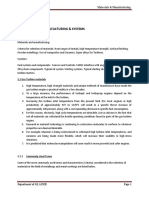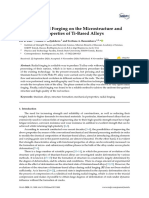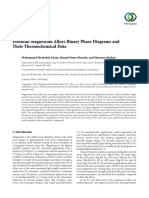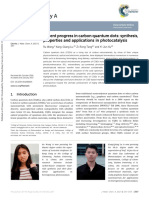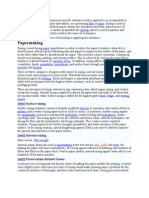0 ratings0% found this document useful (0 votes)
4 viewsMetallurgy Assignment
Uploaded by
bezag9905Copyright
© © All Rights Reserved
Available Formats
Download as DOCX, PDF, TXT or read online on Scribd
0 ratings0% found this document useful (0 votes)
4 viewsMetallurgy Assignment
Uploaded by
bezag9905Copyright
© © All Rights Reserved
Available Formats
Download as DOCX, PDF, TXT or read online on Scribd
You are on page 1/ 10
ADAMA SCIENCE AND TECHNOLOGY UNIVERSITY
Materials science and Engineering
Fundamental of Metallurgy
Assignment
Name id
1. Beza Girma UGR/30300/15
2. Kalkidan Shimellis UGR/30752/15
3. Soran Muluneh UGR/31252/15
Submitted to: Tesfaye G/Michael
Submission date: Nov/29/2024
Titanium and manganese alloy
1. Definition
Titanium manganese alloy is a type of alloy that primarily consists of
titanium (Ti) and manganese (Mn) as its main alloying elements. The
addition of manganese to titanium can enhance certain properties of
the base metal, such as strength, ductility, and corrosion resistance.
2. Composition of titanium and manganese alloy
In titanium Manganese alloy manganese act as an alloying element.
They exhibit improved mechanical property like strength and
ductility also corrosion resistance because of titanium.
Typical composition
Titanium (ti): 90-95%
Manganese (mn): 5-10%
It may also include other elements like:
Iron (fe):up to 0.5%
Aluminium (al): up to 5%
Oxygen: in low amount
Carbon: kept below 0.1%.
The composition of titanium manganese alloys can be used for specific
performance requirements, making them versatile materials for various
applications in aerospace, medical, marine, and automotive industries.
3. Characteristics and properties
Titanium manganese alloys offer a unique combination of strength,
lightweight nature, corrosion resistance, and biocompatibility,
making them valuable materials in advanced engineering
applications.
3.1 Mechanical properties and characteristics of titanium
manganese alloy
High tensile strength: enhance through alloying and heat
treatment. Ranges from 600 mpa to over 1000 mpa.
Good yield strength: resistance to deformation under load.
Comparable to or higher than of pure titanium.
Excellent ductility: deformed plastically without fracture.
High fatigue strength
Variable hardness
Good impact toughness: ability to absorb energy and deform
plastically before fracturing.
Good workability: readily formed into complex shapes.
Allotropic behavior
Good corrosion resistance.
3.2 Physical characteristics and properties of titanium manganese
Lightweight: Titanium is known for its low density (approximately
4.5 g/cm³), and the addition of manganese does not significantly
increase the density of the alloy.
High Melting Point: ranging from 1660°C to 1700°C (3020°F to
3090°F) depending on the specific composition.
Strength: The presence of manganese contributes to solid
solution strengthening.
Ductility: These alloys generally demonstrate good ductility,
allowing them to be formed into various shapes without
fracturing. This is important for manufacturing processes such as
forging and machining.
Fatigue Resistance: Ti-Mn alloys often show excellent fatigue
resistance, making them suitable for dynamic loading
applications, such as in aerospace components.
Formability: Their workability is generally good, although care
must be taken during processing due to the potential for work
hardening.
3.3 Chemical properties and characteristics of titanium
manganese alloys
Chemical Reactivity: Titanium is relatively inert at room
temperature but can react with various elements at elevated
temperatures. Manganese, being a more reactive metal, may
influence the overall reactivity of the alloy, particularly in high-
temperature applications.
Hydrogen Absorption: Titanium has a high affinity for hydrogen,
which can lead to embrittlement if not managed properly. The
presence of manganese may alter the hydrogen absorption
characteristics, potentially affecting the alloy's performance.
Oxidation Behavior: show good oxidation resistance due to the
formation of protective oxide layers.
Oxide Layer Characteristics: The composition and morphology of
the oxide layer formed on Ti-Mn alloys can be influenced by the
alloying elements, which may impact the overall performance in
corrosive environments.
Biomedical Applications: The chemical properties that contribute
to this include low toxicity, favorable corrosion resistance in
bodily fluids, and suitable mechanical properties for implants.
Surface Modification: Chemical surface treatments can enhance
the biocompatibility and corrosion resistance of Ti-Mn alloys,
making them suitable for various medical devices.
3.4 Electronical properties and characteristics of titanium
manganese alloys
Electrical Conductivity: The electrical conductivity of Ti-Mn alloys
is generally lower than that of pure titanium but can vary
significantly based on the manganese content. Manganese is a
transition metal with relatively high electrical resistivity, which
can lead to decreased overall conductivity in the alloy.
Influence of Composition: Increasing the manganese content can
further reduce conductivity due to the increased resistivity
associated with manganese.
Carrier Concentration: influencing its semiconducting properties.
Dielectric Constant: The dielectric constant can vary based on
composition and microstructure, influencing how these materials
interact with electric fields.
Electrochemical Properties: an important factor influencing their
electrical performance over time. Corrosion can lead to increased
resistivity and degradation of electrical properties.
3.5 Magnetic characteristics and properties of titanium
manganese alloys
Ferromagnetism: Manganese is a ferromagnetic material, and its
presence in titanium-manganese alloys can impart ferromagnetic
properties to the alloy.
Paramagnetism: In certain Ti-Mn compositions, especially those
with lower manganese content or specific microstructures, the
alloys may exhibit paramagnetic behavior rather than
ferromagnetism. This occurs when the magnetic moments of the
manganese atoms do not align in a way that produces a net
magnetic moment.
Manganese Content: Higher manganese content generally
enhances ferromagnetic properties, while lower concentrations
may lead to weaker magnetic responses.
Directional Dependence: the magnetic properties vary with
direction within the material. This anisotropy can be influenced by
the alloy's crystallographic structure and processing history.
Electronics: Their magnetic behavior can also be leveraged in
electronic applications, such as in the development of magnetic
storage devices or components.
Titanium manganese alloys offer a unique combination of strength,
lightweight nature, corrosion resistance, and biocompatibility, making
them valuable materials in advanced engineering applications.
4. Microstructure of titanium manganese alloys
The microstructure of titanium manganese alloys plays a crucial role in
determining their mechanical and physical properties. The
characteristics of the microstructure can vary based on the
composition, processing methods, and heat treatments applied to the
alloy. Here are some key aspects of the microstructure of titanium
manganese alloys:
Phases Present:
• Alpha (α) Phase: Titanium primarily exists in the alpha phase at
lower temperatures. This phase has a hexagonal close-packed
(HCP) structure, which contributes to the alloy's strength and
ductility.
• Beta (β) Phase: At higher temperatures, titanium can
transform into the beta phase, which has a body-centered cubic
(BCC) structure. The presence of manganese can stabilize the β
phase, especially at room temperature, depending on the alloy
composition.
• TiMn Intermetallic Compounds: In some titanium manganese
alloys, intermetallic compounds such as TiMn may form, which
can influence the mechanical properties and corrosion resistance.
Grain Structure:
The grain size and morphology are critical factors that affect the
mechanical properties of the alloy. Fine-grained structures
typically enhance strength due to the Hall-Petch effect, while
coarser grains may improve ductility.
Processing methods such as forging, rolling, or heat treatment can
significantly influence grain size and distribution.
Precipitation Strengthening:
The presence of manganese can lead to precipitation hardening
mechanisms where fine precipitates form within the matrix during
aging treatments. These precipitates can impede dislocation
motion and enhance strength.
Surface Microstructure:
The surface microstructure may differ from the bulk due to
oxidation or other environmental factors. Surface treatments may
be employed to enhance corrosion resistance or wear properties.
The microstructure of titanium manganese alloys is complex and
influenced by various factors including composition, processing
techniques, and thermal treatments
5. Application of titanium manganese alloys
Titanium manganese alloys exhibit a unique combination of
properties that make them suitable for various applications across
different industries. Here are some notable applications:
Aerospace Industry: Structural Components: Due to their high
strength-to-weight ratio and corrosion resistance, titanium
manganese alloys are used in aircraft components, including
structural parts, fasteners, and landing gear.
Biomedical Applications: Implants and Prosthetics: The
biocompatibility of titanium alloys makes them ideal for medical
implants, such as dental implants, orthopedic devices, and
prosthetic limbs. Surgical Instruments: Titanium manganese alloys
can be used to manufacture lightweight and durable surgical
instruments.
Automotive Industry: Lightweight Components: The automotive
industry utilizes these alloys for manufacturing lightweight
structural components that improve fuel efficiency without
compromising strength.
Sports Equipment: High-Performance Gear: The lightweight and
strong properties of these alloys are utilized in the production of
high-performance sports equipment, such as bicycle frames, golf
clubs, and tennis rackets.
Nuclear Reactor Components: Due to their strength and
resistance to radiation damage, these alloys can be used in
components of nuclear reactors and other related applications.
Overall, titanium manganese alloys are versatile materials with a wide
range of applications due to their strength, lightweight nature,
corrosion resistance, and biocompatibility. As research continues into
optimizing their properties through alloying and processing techniques,
their application scope may expand further into new fields.
You might also like
- Designation: Magnesium Alloys Are Mixtures ofNo ratings yetDesignation: Magnesium Alloys Are Mixtures of4 pages
- Perspective_Chapter_Titanium_-_A_Versatile_Metal_iNo ratings yetPerspective_Chapter_Titanium_-_A_Versatile_Metal_i21 pages
- Material Science: Prof. Satish V. KailasNo ratings yetMaterial Science: Prof. Satish V. Kailas12 pages
- Design_and_Parametric_Analysis_of_Helical_Coil_conNo ratings yetDesign_and_Parametric_Analysis_of_Helical_Coil_con8 pages
- Module - 2: Materials and Manufacturing & SystemsNo ratings yetModule - 2: Materials and Manufacturing & Systems15 pages
- Metal Matrix Composites What Are Metal Matrix Composites?No ratings yetMetal Matrix Composites What Are Metal Matrix Composites?1 page
- Structure and Properties of Titanium For Dental Implants: M. Greger, M. Erný, L. Kander, J. KliberNo ratings yetStructure and Properties of Titanium For Dental Implants: M. Greger, M. Erný, L. Kander, J. Kliber4 pages
- A Brief Review On Machinability of Titanium and Its Alloys For Nuclear ApplicationNo ratings yetA Brief Review On Machinability of Titanium and Its Alloys For Nuclear Application3 pages
- A Brief Review On Machinability of Titanium and Its Alloys For Nuclear ApplicationNo ratings yetA Brief Review On Machinability of Titanium and Its Alloys For Nuclear Application3 pages
- Analysis of Mechanical Properties of Aluminium MetalNo ratings yetAnalysis of Mechanical Properties of Aluminium Metal25 pages
- Effect of Radial Forging On The Microstructure and Mechanical Properties of Ti-Based AlloysNo ratings yetEffect of Radial Forging On The Microstructure and Mechanical Properties of Ti-Based Alloys12 pages
- Design and Modal Analysis of Turbine Compressor BladeNo ratings yetDesign and Modal Analysis of Turbine Compressor Blade8 pages
- Evaluation of Mechanical Properties of Aluminum Metal Matrix Composites PDFNo ratings yetEvaluation of Mechanical Properties of Aluminum Metal Matrix Composites PDF5 pages
- Studies To Improve The Mechanical Properties of 319 Aluminium Alloy by Magnesium AdditionNo ratings yetStudies To Improve The Mechanical Properties of 319 Aluminium Alloy by Magnesium Addition8 pages
- A Brief Review of Carbon Nanotube Reinforced Metal Matrix Composites For Aerospace and Defense ApplicationsNo ratings yetA Brief Review of Carbon Nanotube Reinforced Metal Matrix Composites For Aerospace and Defense Applications25 pages
- Aircraft Materials and Manufacturing ProcessNo ratings yetAircraft Materials and Manufacturing Process125 pages
- Biomaterials, Surface Area of Dental ImplantsNo ratings yetBiomaterials, Surface Area of Dental Implants27 pages
- Unit 1 - Basic Mechanical Engineering - WWW - Rgpvnotes.inNo ratings yetUnit 1 - Basic Mechanical Engineering - WWW - Rgpvnotes.in9 pages
- Review Article: Essential Magnesium Alloys Binary Phase Diagrams and Their Thermochemical DataNo ratings yetReview Article: Essential Magnesium Alloys Binary Phase Diagrams and Their Thermochemical Data34 pages
- Advancements in Magnesium Alloys for Lightweight and High-Performance ApplicationsNo ratings yetAdvancements in Magnesium Alloys for Lightweight and High-Performance Applications5 pages
- Development & Screening Approach For Lipid Nanoparticle: A ReviewNo ratings yetDevelopment & Screening Approach For Lipid Nanoparticle: A Review7 pages
- 2 - Recent Progress in Carbon Quantum Dots - Synthesis Properties and Applications in Photocatalysis (Done)No ratings yet2 - Recent Progress in Carbon Quantum Dots - Synthesis Properties and Applications in Photocatalysis (Done)18 pages
- A Short Review on Biological Activities of Schiff Base Ligands and Its Metal Complexes by Asnurifah Binti Was 2018674558correction_09082021No ratings yetA Short Review on Biological Activities of Schiff Base Ligands and Its Metal Complexes by Asnurifah Binti Was 2018674558correction_0908202160 pages
- CARDIF Caluanie Muelear Oxidize DATA SHEETNo ratings yetCARDIF Caluanie Muelear Oxidize DATA SHEET10 pages
- Kaliborite KHMG B O (OH) 4H O: Crystal DataNo ratings yetKaliborite KHMG B O (OH) 4H O: Crystal Data1 page
- NEET-Leader - Phase 2 & 3 - Minor Test - 7 - 10.01.2024 - Key & SolutionsNo ratings yetNEET-Leader - Phase 2 & 3 - Minor Test - 7 - 10.01.2024 - Key & Solutions4 pages
- Ch. 1 Particulate Nature of Matter 2023 Year 10No ratings yetCh. 1 Particulate Nature of Matter 2023 Year 1010 pages
- AD0012LC Post Column Derivatization AflatoxinNo ratings yetAD0012LC Post Column Derivatization Aflatoxin4 pages
- Pharmaceutical Organic Chemistry Lab 1 PHC464No ratings yetPharmaceutical Organic Chemistry Lab 1 PHC4645 pages
- Overview of The Availability and Utilization of Kaolin As A Potential Raw Material in Chemicals & Drugs Formulation in Nigeria100% (1)Overview of The Availability and Utilization of Kaolin As A Potential Raw Material in Chemicals & Drugs Formulation in Nigeria6 pages
- Copy of Week 6 Homework ÔÇô Solution Equilibria Part II SolutionNo ratings yetCopy of Week 6 Homework ÔÇô Solution Equilibria Part II Solution17 pages
- Metal Corrosion and Its Prevention: Material ScienceNo ratings yetMetal Corrosion and Its Prevention: Material Science49 pages
- TDS - M - Nitrates - Calcium - Manuchar Agro - REACH.No ratings yetTDS - M - Nitrates - Calcium - Manuchar Agro - REACH.2 pages
- Perspective_Chapter_Titanium_-_A_Versatile_Metal_iPerspective_Chapter_Titanium_-_A_Versatile_Metal_i
- Design_and_Parametric_Analysis_of_Helical_Coil_conDesign_and_Parametric_Analysis_of_Helical_Coil_con
- Metal Matrix Composites What Are Metal Matrix Composites?Metal Matrix Composites What Are Metal Matrix Composites?
- Structure and Properties of Titanium For Dental Implants: M. Greger, M. Erný, L. Kander, J. KliberStructure and Properties of Titanium For Dental Implants: M. Greger, M. Erný, L. Kander, J. Kliber
- A Brief Review On Machinability of Titanium and Its Alloys For Nuclear ApplicationA Brief Review On Machinability of Titanium and Its Alloys For Nuclear Application
- A Brief Review On Machinability of Titanium and Its Alloys For Nuclear ApplicationA Brief Review On Machinability of Titanium and Its Alloys For Nuclear Application
- Analysis of Mechanical Properties of Aluminium MetalAnalysis of Mechanical Properties of Aluminium Metal
- Effect of Radial Forging On The Microstructure and Mechanical Properties of Ti-Based AlloysEffect of Radial Forging On The Microstructure and Mechanical Properties of Ti-Based Alloys
- Design and Modal Analysis of Turbine Compressor BladeDesign and Modal Analysis of Turbine Compressor Blade
- Evaluation of Mechanical Properties of Aluminum Metal Matrix Composites PDFEvaluation of Mechanical Properties of Aluminum Metal Matrix Composites PDF
- Studies To Improve The Mechanical Properties of 319 Aluminium Alloy by Magnesium AdditionStudies To Improve The Mechanical Properties of 319 Aluminium Alloy by Magnesium Addition
- A Brief Review of Carbon Nanotube Reinforced Metal Matrix Composites For Aerospace and Defense ApplicationsA Brief Review of Carbon Nanotube Reinforced Metal Matrix Composites For Aerospace and Defense Applications
- Unit 1 - Basic Mechanical Engineering - WWW - Rgpvnotes.inUnit 1 - Basic Mechanical Engineering - WWW - Rgpvnotes.in
- Review Article: Essential Magnesium Alloys Binary Phase Diagrams and Their Thermochemical DataReview Article: Essential Magnesium Alloys Binary Phase Diagrams and Their Thermochemical Data
- Advancements in Magnesium Alloys for Lightweight and High-Performance ApplicationsAdvancements in Magnesium Alloys for Lightweight and High-Performance Applications
- The Product and Facility Integration in Surface TreatmentFrom EverandThe Product and Facility Integration in Surface Treatment
- Development & Screening Approach For Lipid Nanoparticle: A ReviewDevelopment & Screening Approach For Lipid Nanoparticle: A Review
- 2 - Recent Progress in Carbon Quantum Dots - Synthesis Properties and Applications in Photocatalysis (Done)2 - Recent Progress in Carbon Quantum Dots - Synthesis Properties and Applications in Photocatalysis (Done)
- A Short Review on Biological Activities of Schiff Base Ligands and Its Metal Complexes by Asnurifah Binti Was 2018674558correction_09082021A Short Review on Biological Activities of Schiff Base Ligands and Its Metal Complexes by Asnurifah Binti Was 2018674558correction_09082021
- NEET-Leader - Phase 2 & 3 - Minor Test - 7 - 10.01.2024 - Key & SolutionsNEET-Leader - Phase 2 & 3 - Minor Test - 7 - 10.01.2024 - Key & Solutions
- Overview of The Availability and Utilization of Kaolin As A Potential Raw Material in Chemicals & Drugs Formulation in NigeriaOverview of The Availability and Utilization of Kaolin As A Potential Raw Material in Chemicals & Drugs Formulation in Nigeria
- Copy of Week 6 Homework ÔÇô Solution Equilibria Part II SolutionCopy of Week 6 Homework ÔÇô Solution Equilibria Part II Solution
- Metal Corrosion and Its Prevention: Material ScienceMetal Corrosion and Its Prevention: Material Science
- TDS - M - Nitrates - Calcium - Manuchar Agro - REACH.TDS - M - Nitrates - Calcium - Manuchar Agro - REACH.









